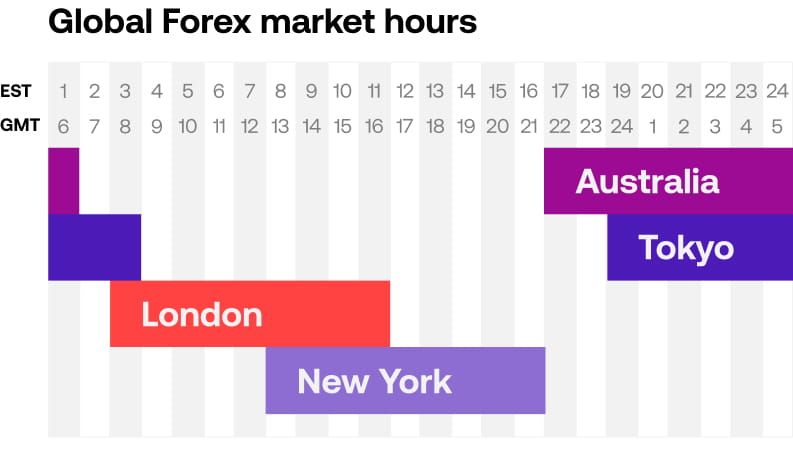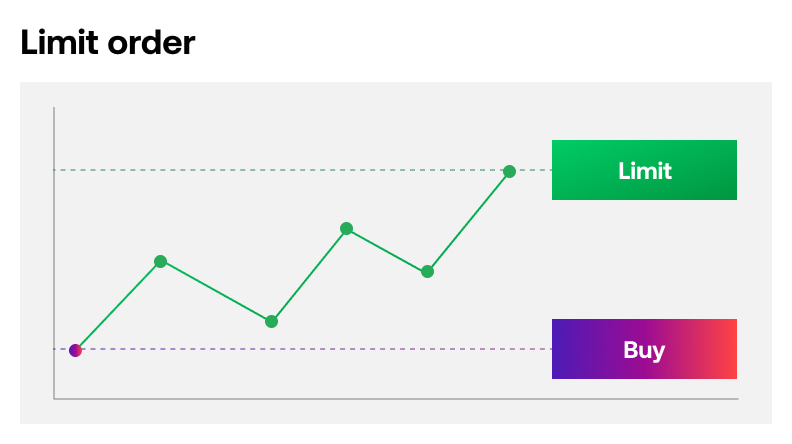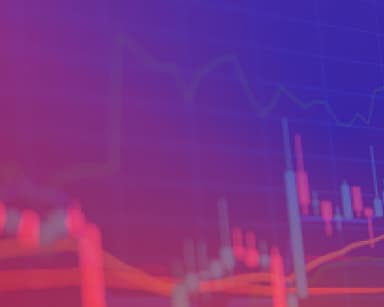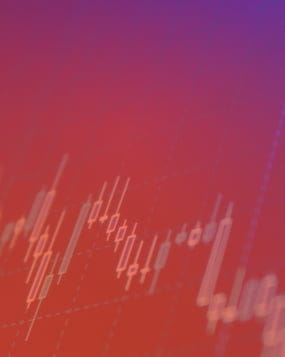According to the Bank for International Settlements, forex markets are more highly traded than any other market, with transactions worth trillions of dollars taking place every day. In this forex trading guide, we’ll explain how the currency markets work and how you can trade them.
Forex trading step-by-step:
- Choose a currency pair
- Decide to buy or sell your currency
- Manage your risk in forex trading
- Monitor and close your forex trade
CREATE YOUR FOREX TRADING ACCOUNT
View further forex trading instructions below:
- How do currency markets work?
- Forex trading examples
- How to start trading forex?
- Types of currency pairs
- What moves the forex markets?
- Start forex trading
- Forex trading FAQs
How do currency markets work?
Currency markets work via a global network of banks, business and individuals that are constantly buying and selling currencies . Unlike most financial assets – such as shares or commodities – the foreign exchange market has no physical location and trades 24 hours a day.
This is called an over-the-counter market, and it means that currency prices are constantly fluctuating in value against each other, potentially offering a greater number of forex trading opportunities.
There are four main forex trading hubs: London, Tokyo, New York and Sydney. When trading stops in one, it starts in another.

However, forex is also traded across Zurich, Frankfurt, Hong Kong, Singapore and Paris.
At City Index, you can speculate on the future direction of currencies, taking either a long (buy) or short (sell) position depending on whether you think a currency will go up or down.
Forex trading examples
For more information on how forex trading works, look through our list of forex trading examples.
To start trading forex, you’ll need to get to know a few key concepts and terms. Let’s take a look at each in turn.
Base currencies and quote currencies
Forex is always traded in pairs. That means when you buy one currency, you do so by selling another. And when you sell one currency, you do so by buying another.
When you buy EUR/USD, for example, you're buying the euro while selling the US dollar.
The two currencies in a pair are known as the base and the quote.
- The base is the first currency. In EUR/USD, it is the euro
- The quote is the second currency. In EUR/USD, it is the dollar

A forex pair tells you how much of the quote currency you'll need to exchange for a single unit of the base. If EUR/USD is trading at 1.1810, then you'll need to sell 1.1810 USD to buy a single euro.
Forex traders look to take advantage of changes in the relative value of the base and quote currency in a pair. You could, for instance, buy euros for dollars when EUR/USD is at 1.1810. If the euro strengthens against the US dollar, then your euros will be worth more dollars – so can sell euros for dollars and keep the difference as profit.
If EUR/USD had dropped in price, though, you might have to sell your euros for less than you bought them. In this case, you would make a loss.
For more information on pairs, take a look at our What is forex trading? page.
Pips, lots and margin
Pips measure how much a currency pair has moved. A single pip is equivalent to a one-digit move in the fourth number after the decimal point. If EUR/USD moves from 1.1810 to 1.1817, it has gone up seven pips.
One key exception to this rule is when the Japanese yen is the quote currency. In this case, a pip is calculated as a one-digit move in the second number after the decimal point. If USD/JPY moves from 110.05 to 110.01, it has fallen four pips.
As you may have noticed, even a 50-pip move won't earn you much if you trade 100 or 500 units of currency. That’s why most forex traders buy and sell forex in lots – batches of currencies that enable you to take advantage of even relatively small price moves.
A standard lot is equivalent to trading 100,000 units of currency. Buying one lot of EUR/USD means purchasing 100,000 euros for their value in US dollars.
To avoid having to tie up all their capital when opening one position, most forex traders use leverage. With leverage, you only put up a fraction of your position's full value to open a trade. The amount you are required to put up is known as your margin.
How to start trading forex
1. Choose a currency pair
The first step to opening a forex trade is to decide which currency pair you wish to trade. There are over 80 to choose from.
Types of currency pairs
There are three main categories of forex pair: majors, minors (or major crosses) and exotics.
- Majors currency pairs consist of the world’s biggest currencies against the US dollar and make up around 85% of forex trading volume. The majors are EUR/USD, USD/JPY, GBP/USD, AUD/USD and USD/CHF.
- Minors currency pairs are all other combinations of the world’s biggest currencies, such as EUR/GBP and GBP/JPY. These are also often referred to as major cross pairs
- Exotics currency pairs are pairs that include less-traded currencies, such as the Turkish lira (TRY) or Mexican peso (MXN)
Most new traders will pick one or two major currency pairs to focus on, often starting out with euro-dollar (EUR/USD). This is the world’s most traded currency pair, and typically has the tightest spreads.
2. Decide to buy or sell your currency
Now you know which currency you’re trading – and how you want to trade it – it’s time to decide whether to go long or short.
All forex is quoted in terms of one currency versus another. As we’ve covered, each currency pair has a ‘base’ currency and a ‘quote’ currency. The base currency is the currency on the left of the currency pair and the quote currency is on the right. Essentially, when trading foreign currencies, you:
BUY a currency pair if you believe that the base currency will strengthen against the quote currency, or the quote currency will weaken against the base currency.
- This is a long position, so your profits will rise if the currency pair’s value rises
- However, for every point the pair falls below your open level, you will incur a loss
SELL a currency pair if you believe that the value of the currency pair will decrease – meaning the base currency will weaken in value against the quote currency, or the quote currency will strengthen against the base currency.
- This is a short position, so your profits will rise if the pair’s price falls
- However, for every point the pair rises above your open level, you will incur a loss
What is the spread in forex trading?
The spread is the difference between the buy and sell prices of a forex pair. When you trade FX, you’ll see two prices listed: the first is the sell price (or bid) and the second is the buy price (or offer). The difference between them is the spread, which covers the cost of the trade.
If you want to go long on a pair, you’ll open your trade at the offer price. Then when you want to close your position, you’ll sell at the bid price. If you’re going short, you’ll do the opposite.

3. Manage your risk
Risk management is crucial for successful forex trading – and a key element of risk management is the use of orders.
There are two main types of orders: stop loss orders and take profit orders (sometimes called a limit). Both act as instructions to automatically close a position when its price reaches a specific level predetermined by you.
What is a stop loss order?
A stop loss order is an instruction to close out a trade to help minimise losses. There are three types of stop loss orders: standard, trailing and guaranteed.

A standard stop loss order, once triggered, closes the trade at the best available price. There is a risk therefore that the closing price could be different from the order level if market prices gap.
A guaranteed stop loss however, for which a small premium is charged upon trigger, guarantees to close your trade at the stop loss level you have determined, regardless of any market gapping.
What is a limit order?
A limit order (or take profit) is an instruction to close out a trade at a price that is better than the current market level and is used to help lock in price targets.

Standard stop losses and limit orders are free to place and can be implemented in the dealing ticket when you first place your trade, and you can also attach orders to existing open positions.
Learn more about risk management.
4. Monitor and close your forex trade
Once open, your trade’s profit and loss will fluctuate as the market’s price moves.
You can track market prices, see your unrealised profit/loss update in real time, attach orders to open positions and add new trades or close existing trades from your computer or smartphone.
When you are ready to close your trade, you do the opposite to the opening trade. If you bought three CFDs to open, you would sell three CFDs to close. By closing the trade, your net open profit and loss will be realised and immediately reflected in your account cash balance.
Please note that City Index CFD accounts are FIFO - if you have more than one open position in the same market, the oldest position will be closed first. To read more about this please visit our help and support section.
What moves forex markets?
One important aspect of trading currencies is learning what affects their prices. Remember, forex pair prices will move based on the relative strengths of both currencies – so keep an eye out for any developments that might move either the base or the quote when trading.
Here are a few factors that often move currency markets:
Start forex trading
To begin forex trading with City Index, simply follow our three-step guide to creating a trading account and you could be placing your first forex trade within minutes – subject to review and approval.
Step 1: Create a City Index or MT4 trading account
- You need to create a trading account with us in order to start trading forex. Our application process is simple and secure; you can apply for an online trading account at any time by filling in our online application form
- Once we’ve successfully completed the verification process, we’ll send you an account number by email to confirm that your trading account is open
Step 2: Fund your trading account
- Once your trading account is open, you’ll need to transfer funds into it to start trading forex. You can do this in a variety of ways via the 'Account Funding' tab in the trading platform
- Your initial deposit must be at least $150 (or $250 for credit/debit cards)
- For more information on how you can transfer funds in and out of your trading account, see our help and support section
Step 3: Start trading
- Now you have an online trading account and have deposited funds, you can start trading forex
- Log in, pick your currency pairs and open a position
- For more details of the markets available for you to trade, click on the online Market Information icon in the trading platform
Forex trading FAQs
How is the forex market regulated?
The forex market is regulated by several different governmental and independent bodies all around the world. Some of these include:
- The National Futures Association (NFA) and Commodities Futures Trading Commission (CFTC) in the US
- The Financial Conduct Authority (FCA) in the UK
- The Financial Services Agency (FSA) in Japan
- The Australian Securities and Investments Commission (ASIC) in Australia
These bodies set the standards by which every forex broker must comply, which helps ensure that currency trading is ethical and fair.
How much money is traded on the forex market daily?
In 2022, there was US$7.5 trillion of forex traded on average each day according to the Bank for International Settlements. That makes it the biggest financial market in the world by volume – by some distance.
Around US$553 billion is traded on the global stock market each day on average, for example. That makes forex more than 10 times bigger.
What are gaps in forex trading?
Gaps in forex trading are when a market moves from one price to another without any trading in between. They occur most often over the weekend – a market may close at one price on Friday, then open higher or lower the following Monday.
However, gaps can also appear over short timeframes, especially when a market is very volatile.








